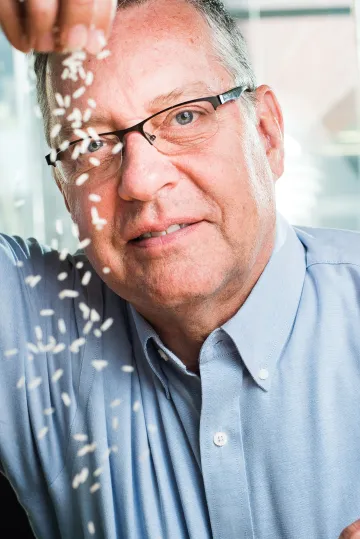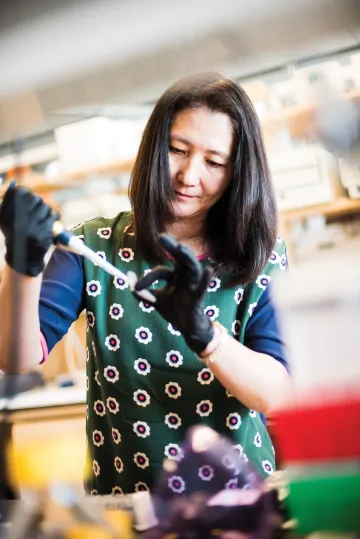A Genome Genius
Endowed chair Rod Wing takes aim at world hunger
In a tiny greenhouse on top of the Sixth Street garage, just west of the football stadium, dozens of green rice shoots glisten in the sun, awaiting their roles in the battle against world hunger.
One day, these 210 shoots will pass along to their offspring ancient genes associated with traits that result in higher yields, pest resistance and drought tolerance. Those genes — and traits — will then be bred into popular cultivars using conventional breeding practices.
The project is the latest for Rod Wing, an expert in comparative and evolutionary genomics for crops like rice and corn, the founding director of the Arizona Genomics Institute, and the UA’s Bud Antle Endowed Chair for Excellence in Agriculture and Life Sciences. In 2005, Wing, his UA team at the interdisciplinary BIO5 Institute and a consortium called the International Rice Genome Sequencing Project completed the sequencing of the rice genome — the first complete sequencing of a major crop plant.
The IRGSP brings together academics, officials and industry experts from nations including Japan, China, Taiwan, South Korea, India, Thailand, France, Brazil and the United Kingdom. As the world’s population soars, its work is ever more crucial; rice, according to Wing, is the most important food crop in the world.

Rod Wing
The genus Oryza includes two domesticated species of rice, Asian and African, as well as 22 wild relatives that span the globe. Rice is genetically complex, with about 37,500 genes — 7,500 more than the human genome. To successfully sequence the rice genome, Wing and his team developed “BAC libraries,” frameworks constructed using bacterial artificial chromosomes, or BACs, that are clones containing very large DNA fragments and thus help fill in gaps that are an inevitable part of sequencing.
“The genome consists of puzzles within puzzles,” Wing says. “And the BAC libraries are the puzzle pieces.” Within each of those large puzzle pieces are 150,000 combinations of the letters AGCT, representing the four nucleotide bases that make up all DNA.
“We made the pieces, and we knew the order of those pieces in the genome,” Wing continues. “When we had figured that out, we distributed those pieces to labs around the world to do the sequencing of the rice genome.”
In 2004, at a meeting in Tucson, the team announced the completion of the finished sequence. In 2005, seven years after Wing started out, the work was published in Nature magazine. For his leadership of the project, Wing received the USDA’s highest recognition, the Secretary’s Honor Award.
“That was, and is, the highest quality genome that has ever been produced for a crop plant,” Wing says. The reference genome for rice covers all the genes that the UA team sequenced with 99.99 percent accuracy — that is, no more than one error in every 10,000 of those nucleotide bases. However, Wing says, “We were able to do this for about 90 percent of the genome, and the rest was still missing.” Work on filling in the gaps continues.
Unlike the private companies studying rice genomes, the IRGSP team immediately published its findings in open databases so labs worldwide could experiment with it. Now, the genome map has become a crucial reference point to help locate specific gene changes that create desirable traits in rice plants and their offspring, called lines.
The Wing team’s original sequence is the research framework still in use by the IRGSP. The research will also help improve other cereal grasses like wheat, corn, oats, barley and sorghum. In 2009, Wing’s team were leaders in sequencing the genome of corn, which was published in the prestigious journal Science. They applied the same strategy they used for rice on corn’s even larger genome.
As hybrids, the 210 rice plants on the roof of the Sixth Street garage — the offspring of two strong parent plants in China, selected by Wing’s partners — are each a bit different. And, due to hybrid vigor, they all are likely to be more robust than the parents.
At about 100 days, each shoot will grow its panicle — the stalk that bears flowers and eventually rice kernels. Later, the plants will move to fields that are part of new high-tech facilities at the UA’s Maricopa Agricultural Center, just off I-10 south of Phoenix. Robotic tractors, drones and video monitors will watch each plant and send data back for analysis.
The goal of all this work is to improve crop production, building on the strengths of ancient genes to survive in stressful environments. The UA team is trying to pinpoint the regulatory mechanisms by which genes control features like the ability to cope with regional challenges such as soil composition, lack of water for irrigation and climate problems linked to global warming. Hardy, efficient crops also offer environmental benefits, as they require fewer chemical fertilizers to grow well.

Seunghee Lee, assistant research scientist, preparing a sample for genome sequencing.
“By sequencing their genomes and then mapping a gene back to the rice reference genome, you can learn why it looks like this in this country, or like that in that region,” Wing says. “We can say, ‘This is what we want for the ideal rice.’ But you might have the best quality rice in the world and in Africa it won’t do well. So you take that killer rice and you cross in the genes that are adapted to Africa, and you have this great tasting rice, high yielding, but it can also survive in Africa.”
Wing, who was named a fellow of the American Association for the Advancement of Science in 2010, distinguishes his work from GMOs, or genetically modified organisms, in which DNA has been altered with DNA of another organism. “You say ‘GMO’ and many people are freaked out,” he says. “They do have a role to play, a limited role. But we just are trying to study natural variation and make better use of it. That’s quite different.”
Some of the other samples that the team studies are common cultivated varieties, some are wild. The wild rice holds some of the most intriguing secrets. “These wild relatives contain a virtually untapped reservoir of traits that can be used for crop improvement,” Wing says. The Arizona Genomics Institute, in collaboration with other teams, has led the generation of 11 high-quality draft genomes for 10 wild rice relatives, as well as an independently domesticated rice from Africa called Oryza glaberrima.
The world’s population, currently about 7 billion, is expected to reach 10 billion by 2050. More rice — which is the core of the diet for half the world — will be needed. That’s the heart of what Wing calls “the 10 billion people question.” As he traces his 20 years of work on high-yield rice, he turns philosophical.
“What we are interested in,” Wing says, “is how to feed the world — without destroying our world. Rice will play a big role, with a billion people depending on rice in Asia, Southeast Asia and Africa. In Bangladesh, where growth is out of control.”
Wing quotes Norman Borlaug, who won a Nobel Prize for developing high-yield cereal grains: “Food is the moral right of all who are born into this world.” And yet, Wing observes, half the world goes hungry.
Back in the campus greenhouse, Dave Kudrna, one of the UA’s senior rice experts, bends to examine one proud, tall shoot.
“Look at this guy,” Kudrna says. “It’s more upright. Look at the structure of that plant.”
Thinking about the need to feed the world’s increasing population, he adds, “You think, ‘One of these lines could feed millions of people. One of these could be the answer we’re looking for.’ You are looking at the future.”
‘What we are interested in,’ Wing says, ‘is how to feed the world — without destroying our world.’ — Rod Wing
